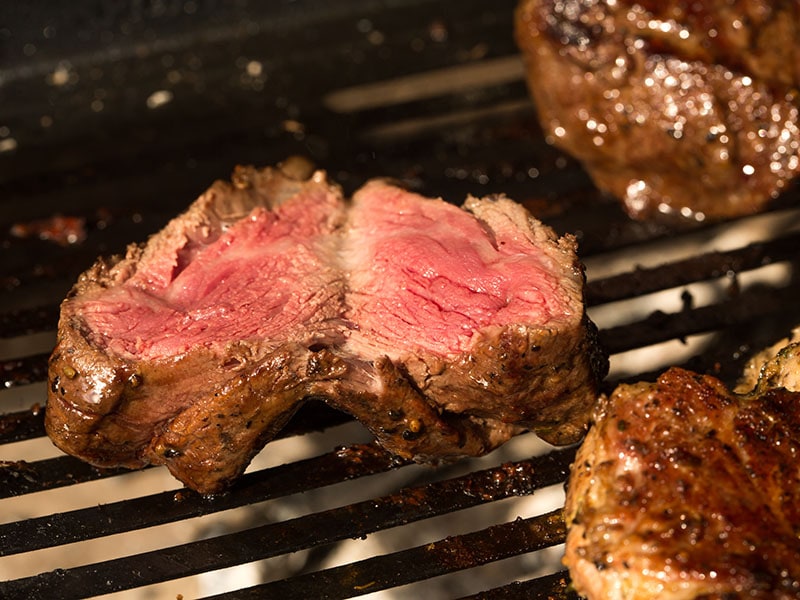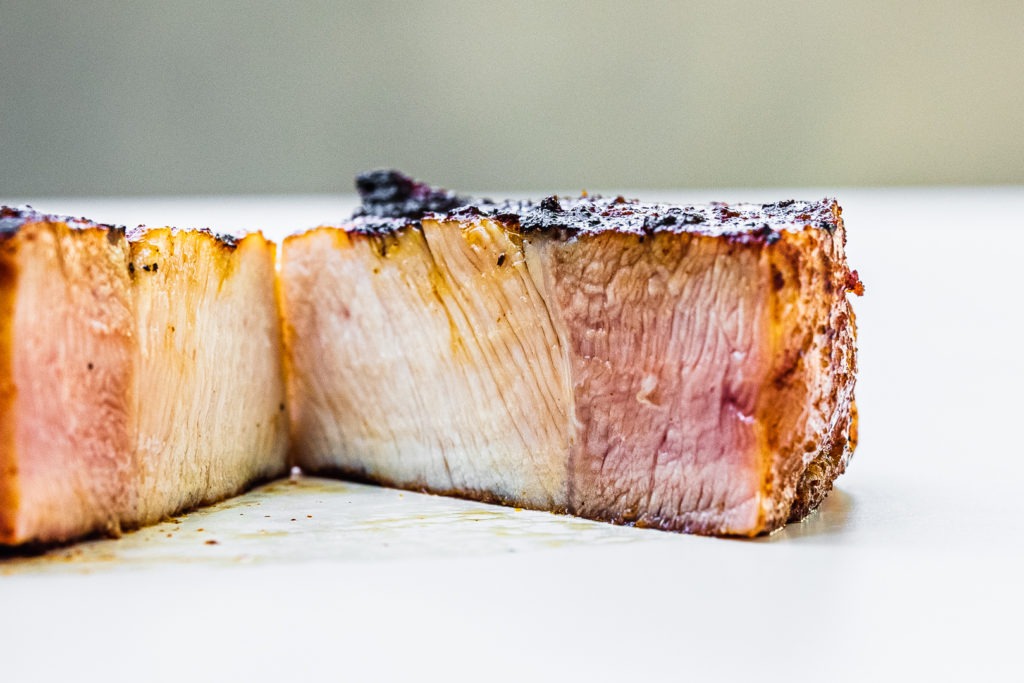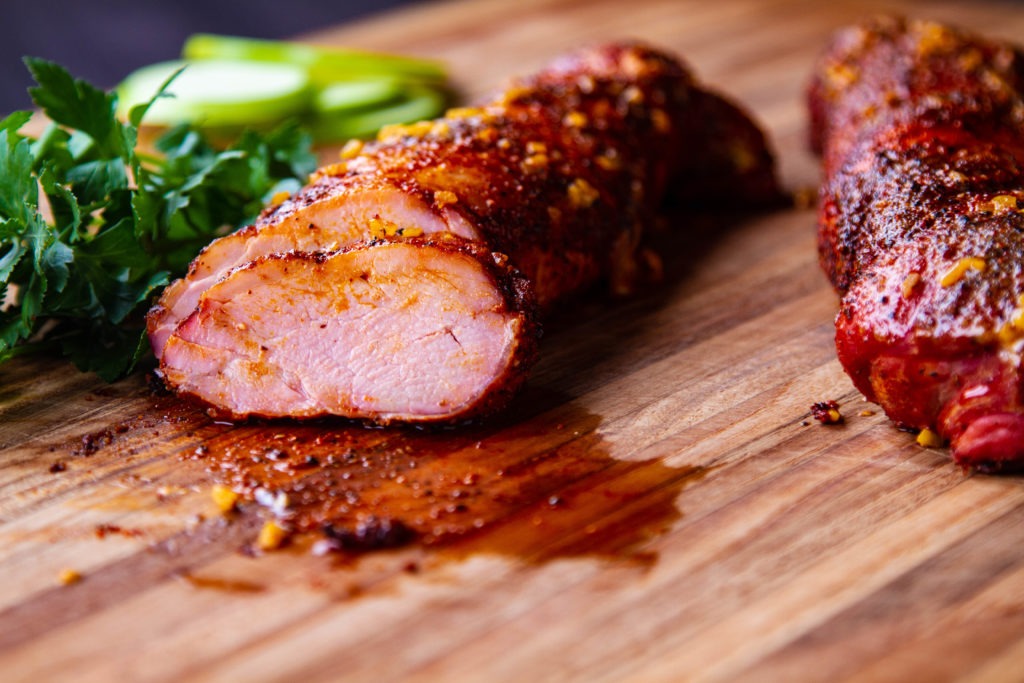There was a real danger to our grandparents’ and grandfathers’ health when they were young that we don’t have to deal with today. No, I’m not talking about the lack of antibiotics, nor the scarcity of nutritious food. It was trichinosis, a parasitic disease that used to be caught from undercooked pork.
The legitimate worry of trichinosis led their mothers to cook their pork until it was very well done. The way they learned to cook it was passed down to their children, and so on until it reached us. The result? We’ve all eaten a lot of too-dry, overcooked pork.
But listen up! The main danger is over, and now we can all enjoy pork as the tasty meat it was always meant to be. With proper temperature control, we can have better pork than our ancestors ever dreamed of. Here, we’ll look at a more nuanced way of thinking about pork temperatures than you’ve likely encountered before.
Pork loin is a popular and versatile cut of meat that can be prepared in everything from roasts to chops. Many home cooks grew up being warned against eating any pink pork, due to fears about trichinosis. However, recommendations have changed and small amounts of pink are now considered safe in pork loin and other cuts. Read on to learn more about the safety of pink pork loin and how to ensure it is properly cooked.
Why Pork Turns Pink
There are a few reasons why properly cooked pork can retain a pinkish hue even when it has reached a safe internal temperature
-
Myoglobin – The natural pigment in meat that causes the pink color. Pork contains lower levels than beef, so it often appears more pale or gray when cooked. However, some pork cuts like the loin do have higher myoglobin content.
-
Brining – Soaking meat in a saltwater solution adds moisture and seasoning This can enhance the pink color.
-
Spices and Marinades – Ingredients like paprika cayenne, and garlic can react with pigments in the meat causing it to appear more pink.
-
Cooking Method – Quick cooking techniques like grilling or pan-searing will sear the outside but leave the inside rarer. The middle isn’t exposed to heat long enough to fully denature the myoglobin.
Is Pink Pork Dangerous?
Up until around 2010, the USDA recommended cooking pork to 160°F, largely due to concerns about trichinosis. This parasite was commonly found in undercooked pork and could cause severe illness. However, improved farming practices have made infection extremely rare, leading health authorities to declare pork safe at lower temperatures.
As long as pork loin and other whole cuts reach the current recommended internal temperature of 145°F with a 3 minute rest time, they are considered safe to eat. At this point, any potential parasites or bacteria will be killed, even if the center still has a hint of pink.
Ground pork should always be cooked more thoroughly to 160°F since the grinding process introduces bacteria throughout the meat.
How to Ensure Pork Loin is Cooked Through
While pink pork loin is not necessarily dangerous, you still want to take steps to confirm it reaches a safe minimum internal temperature. Follow these tips:
-
Invest in a good digital instant-read thermometer. Thermoworks and ThermoPro make reliable models. Check the temperature in the thickest part of the meat.
-
Don’t rely solely on browning, color, or cooking times. Always verify with a thermometer.
-
Bring larger cuts like pork loin roasts to 145°F before removing them from the oven or grill. The temperature will rise another 5-10 degrees during resting.
-
Allow pork to rest at least 3 minutes before slicing or eating. This helps the juices redistribute and reach 140°F throughout.
-
For chops, cook until slightly firmer and opaque in the center. They will reach temperature faster than roasts.
-
Cook ground pork mixtures like sausage to 160°F since bacteria can spread during grinding.
-
Marinate pork in the refrigerator, not sitting out at room temperature where bacteria multiply quickly.
Safe Handling and Storage
Proper storage, handling, and cooking are key to preventing foodborne illnesses from pork. Here are some top food safety tips:
-
Choose fresh pork that looks pinkish-white rather than pale or gray. Avoid meat with discoloration or an odd smell.
-
Store raw pork tightly wrapped in the coldest part of the refrigerator for 3-5 days. Freeze for 1-3 months.
-
Defrost frozen pork slowly in the fridge, never at room temperature where bacteria can multiply.
-
Marinate in the refrigerator in a sealed bag or covered dish. Do not save marinade to reuse after contact with raw pork.
-
Wash hands, utensils, and surfaces after working with raw pork to avoid cross contamination.
-
Use separate cutting boards and plates for raw pork and cooked food.
-
Cook pork thoroughly as described above, using a food thermometer to verify safe temperature.
The prospect of eating pink pork still gives some people pause. However, as long as whole cuts like pork loin reach the safe minimum internal temperature of 145°F, a hint of pink color does not necessarily indicate undercooking. Always use a thermometer to be sure. Follow proper handling and cooking guidelines, and pork loin can be a healthy, delicious addition to your diet without the risks associated with undercooked meat. Stay informed on the latest food safety recommendations for preparing pork and other meats.

Pink pork is ok! At least, it can be.
First, let’s get one thing straight: color is not an indicator of doneness, nor of safety. If you put curing salt in a pork loin and brine it, the pork loin will always be pink, no matter how hot you cook it. (That’s basically what Canadian bacon or peameal bacon is. It’s also not safe to eat a well-done pork loin that has been sitting on the table for too long and has been abused by time and temperature after cooking. It’s not pink at all.
If we can’t rely on color to tell us what is safe, what can we use? Temperature! The USDA calls for pork to be cooked to 145°F (63°C) for food safety—much lower than the 160°F (71°C) that many people think is the cutoff for pork—and a quick reading with a Thermapen® ONE can tell us right away if our pork has achieved that safe temperature.
If you cook your meat slowly, so there isn’t much difference in temperature from the outside to the inside, the meat will be much pinker all the way through than if you turn up the heat quickly and “overcook” the outside of the pork while the middle gets close to being done.


Food safety concerns and thermal thoughts about pork-cooking temperatures
Were they afraid of getting trichinosis, which is what I said before, they cooked their pork too long. But that is a fear that we don’t need to share for two reasons.
First, hog-raising practices have changed and are now mandated to be safer. According to the CDC, “the number of [trichinosis] cases decreased beginning in the middle of the 20th century because of laws that prohibited feeding raw-meat garbage to hogs.” This meant that the trichinella parasite was no longer present in the hogs we eat. In fact, the majority of trichinosis cases now come from undercooked wild animals, not farm-raised pork. (Wild carnivores and omnivores are the main modes of transmission. ).
Second, even if we fear those parasites from our farm-raised hogs, there is a thermal hack to get around them. Freezing cuts of pork that are six inches thick or less to 5°F (-15°C) for 20 days eliminates any trichinella worms that may have somehow gotten into the flesh. Now, 20 days seems like a long time, but when I see a good sale on pork, I tend to stock up, and that pork can easily remain in my freezer for 20 days. When it emerges, it is going to be free of all trichinella, for sure. Well, it will if my freezer goes down to 5°F (-15°C), which I can verify with my ChefAlarm® leave-in probe thermometer.
(Note that the freezing method might not work for wild animals because they can have parasites that don’t die in cold temperatures.) Continue to cook your game well. ).
Once the risk of parasitic infection is taken away, the only risk left is the normal risk of bacterial infection.
Conduct with me, if you will, a thought experiment. Imagine cooking a steak. To what temperature do you cook it? I usually aim for nothing higher than 135°F (57°C). I think you’re happy with the temperature of your steak because you know that it’s safe to eat at that lower temperature.
But think of this: the USDA recommended doneness temp for beef cuts is 145°F (63°C). That’s right, the USDA says you should shy away from anything less than medium-well.
We have put pork on the same level as beef since parasites can no longer live in frozen meat, and I often go against the USDA’s recommendations for beef temperatures. And here’s my own kitchen secret: I also flout them for pork.
You might be shaking your head, your screen, or your trust in my advice right now, but hear me out. Medium-cooked pork loin is delicious. It’s juicy, it’s tender, it has an amazing texture, and it lacks that saw-dusty chewiness of overcooked pork. And some cuts, especially the tenderloin, are even better cooked as low as medium-rare.
Naturally, this option is not for everyone. Yes, technically there is risk. But there is also a risk with every steak. That’s why every steakhouse has that small disclaimer at the bottom of the menu that protects the restaurant from being sued: “eating raw or undercooked potentially hazardous foods may result in foodborne illness.” “Don’t try this if you or someone you care about has a weak immune system or if you should never eat rare or almost-rare meats for safety reasons.”
We think about the pros and cons of every food we eat every day. For this one, the pros are usually greater than the cons.
PINK PORK Experiment – Is Pink Pork GOOD!?
FAQ
Is it okay if pork loin is a little pink?
Is it safe to eat medium rare pork loin?
What color should a pork loin be when cooked?
|
Pork Quality
|
Endpoint Temperature and Time at that Temperature
|
|
|
|
145°F (63°C), 3min
|
160°F (71°C), 1sec
|
|
Normal
|
Pink
|
Very Slightly Pink
|
|
Normal-injected
|
Pink
|
Very Slightly Pink
|
|
PSE
|
Slightly Pink
|
Tan/White
|
What cuts of pork can you eat pink?
Is Pink Pork safe to eat?
Now, pork is safe to eat when it reaches 145°F. The lower temperature means your pork will be juicy, tender and delicious, but it may also have a hint of color. So, is pink pork safe? In short, yes! We used to be afraid of pink pork because of a parasite known as trichinosis, but the risk of contracting it is virtually nonexistent these days.
Can I eat meats like pork if I have PCOS?
Poly cystic ovarian syndrome (PCOS) is a hormonal disorder caused by excessive secretion of androgens and this results in formation of small cyst like follicles in the ovary. This is characterised by many symptoms like obesity, irregular mesturation, insulin resistance. Red meat like mutton, beef and pork are rich in saturated fat and cholesterol so it is not recommended in PCOS.
Can you eat leftover Pink Pork?
Discard any leftover pork that has been sitting out at room temperature for more than two hours. Pink pork is safe to eat as long as it has been cooked to an internal temperature of 145°F (62.8°C). However, ground pork should always be cooked to an internal temperature of 160°F (71.1°C).
Why is Pork Pink when cooked?
The pink color in pork meat is primarily due to the presence of a protein called myoglobin. It is perfectly normal for pork to have a slight pink hue even when adequately cooked. 2. How can I ensure that pork is properly cooked? Use a meat thermometer to check the internal temperature of pork.
